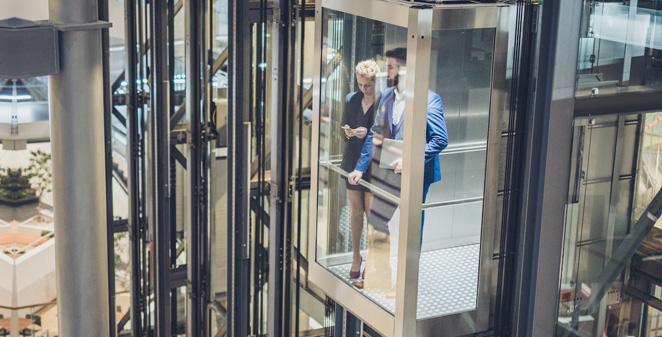Any elevator that is used in a public space is known as a commercial elevator. They are designed to carry heavy loads while standing up to tough work conditions and heavy traffic demands. As such, commercial elevators can refer to passenger elevators in a business setting, such as a hospital, high rise or doctor’s office. This type travels at fast speeds to get multiple people where they need to go in a short amount of time.

Commercial elevators can also refer to freight elevators that transport freight and cargo rather than people. This type usually travels at a slower speed than passenger elevators and usually features vertically-opening doors.
Commercial elevators differ from residential elevators because they are found in commercial buildings and not homes. They are also usually larger, travel at higher speeds, and can handle more weight and traffic than residential elevators.
There are different sizes and types of elevators depending on the type of commercial building:
- Office building, hospital passenger, and hotel elevators typically have a weight capacity of 3,500 pounds.
- Residential commercial elevators (in apartment buildings, for instance) typically have a weight capacity of 2,500 pounds.
- Service elevators (for freight) have a weight capacity of 4,500 pounds.
- Hospital vehicle elevators have a weight capacity of 6,000 pounds (to accommodate medical equipment, wheelchairs and gurneys)
Types of Commercial Elevators
There are many different types of commercial elevators. The one you choose will depend on how tall your building is, the speed you must operate at, and space requirements.
- Hydraulic Elevators: These feature a piston inside a cylinder that is responsible for lifting the cab. These are commonly found in low-rise buildings that don’t exceed 68′ of travel.
- Traction Elevators: With this type, steel ropes raise and lower the cab, typical in mid- to high-rise buildings.
- Machine Room-Less (MRL) Elevators: This type can be either hydraulic or traction, but they do not require a machine room. This opens up the space in your building, plus you use less energy in order to operate the elevator.
ADA Requirements: Commercial Elevators
The ADA made it a requirement in 1990 that all public buildings must be accessible to people with limited mobility. While it initially applied only to new construction, now existing buildings must be retrofitted to meet this requirement.
According to the Americans with Disabilities Act (ADA), elevators must be installed in buildings where there are three or more storiesOR if each floor is larger than 3,000 square feet. Commercial buildings of a smaller size than this are exempt, unless it is one of the following:
- Medical or doctor’s office
- Bus or train station or other public transportation facility
- Airport terminal building
- Large retail space (i.e., shopping mall)
Elevator Requirements
There are three basic types of passenger elevators: standard, destination, and limited-use.
1) Standard Elevators
Standard elevators include enclosed cabs with cable-and-winch lift systems responsible for carrying passengers to all floors. They must be easily found and accessible from public areas, such as the lobby.
2) Destination Elevators
These are a type of specialty elevator that only goes to a specific destination. You will find these in two-story buildings, in buildings with restricted-access floors, and in high-rise buildings (i.e., express elevators to sky lobbies).
3) LULA Elevators – Limited Use, Limited Application
These are for specific applications in special circumstances, usually to meet ADA requirements. You’ll find them in schools, churches, public libraries, and municipal buildings. They follow strict regulations for capacity, size, and standards.
Contact Mowrey Elevator About Our Commercial Elevators
To learn more about our commercial elevators, products, parts or service, call Mowrey Elevator toll free at 800-432-2966 or email us at info@mowreyelevator.com.
